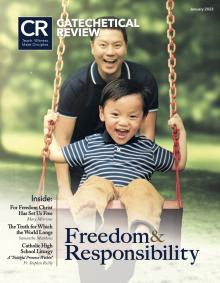Catechetical Committees of the U.S. Conference of Catholic Bishops, 1992–2012
This series of articles seeks to explore an extraordinary fifty-year period in the history of the Church’s catechetical mission. We have already looked briefly at the outcomes of the International Catechetical Study Weeks, the General Catechetical Directory (1971), Evangelii Nuntiandi (1974) and Catechesi Tradendae (1979), Sharing the Light of Faith: National Catechetical Directory of Catholics in the United States (1979), The Rite of Christian Initiation of Adults (1987), and the Catechism of the Catholic Church (1993). In this article, we will turn our attention to the remarkable developments within the structure of the U.S. Bishops Conference that accompanied the Church’s publication of these documents, as well as the historic renewal of her catechetical ministry.
Just as the composition of the Informative Dossier for the Catechism of the Catholic Church was being completed by the staff of the Congregation for the Doctrine of the Faith (CDF) in 1992, the bishops of the United States voted to form an Ad Hoc Committee to Oversee the Implementation of the Catechism in the United States. The chair of the Committee was Bishop Edward Hughes of Metuchen. “The mandate of the ad hoc committee was twofold: to prepare for the reception of the Catechism of the Catholic Church (CCC) in the United States and to assist the bishops of the United States in planning its implementation in their (arch)dioceses.”[i]
The Catechism itself was still more than a year away from the Holy Father’s approval, but both the Holy See and the U.S. bishops were preparing for its publication—the Vatican by preparing the Informative Dossier and the American bishops by establishing a committee to provide for its oversight. These two decisions would prove to be instrumental in paving the way for the favorable reception of the Catechism worldwide and, in a special way, in the United States.
There was no small amount of resistance at the time to the publication of a “universal catechism.” Especially among the ranks of some established national, diocesan, and parish catechetical leaders in the United States, the concept of a single catechism that would be pastorally applicable to all Catholics throughout the world was not possible, let alone desirable. The significant advances that had been made in the necessary inculturation of the Christian message in such documents as Evangelii Nuntiandi, Catechesi Tradendae, the Rite of Christian Initiation of Adults, and several of Pope John Paul II’s encyclicals seemed to argue against a “universal” catechism.
At the same time, in the minds of many in the United States, the use of the word “catechism” conjured images of outmoded and ineffective catechetical methodologies. It reminded many of the Baltimore Catechism, which taught in a question-and-answer format and was intended to be committed to memory. The Baltimore Catechism and other similar instruments had been replaced in favor of materials that were age-appropriate and suitably adapted to the conditions of the person being catechized.
The shorthand designation of “universal catechism,” however, can be misleading. In fact, the mandate given by Pope John Paul II was for a catechism for the universal Church, not a universal catechism. This distinction is important. It is true that there can be only one catechism for the Church throughout the world because the Church holds and teaches the same truth in every place. But a catechism for the universal Church must be the point of reference for the development of national or regional catechisms and other types of catechetical materials. Such catechisms and catechetical materials must be prepared in light of both the catechism of the universal Church and the particularities of the individual cultures in which they will be used. They have to adapt their teaching to the capacity of those who receive it but, at the same time, must transmit the fullness of the truth that God intends to communicate in his self-revelation. In his remarks to the Catechism Commission in 1986, Pope John Paul II addressed this issue:
The catechism which you are called to plan is situated within the church’s great tradition, not as a substitute for diocesan or national catechisms, but as a “point of reference” for them. It is not meant to be, therefore, an instrument of flat “uniformity,” but an important aid to guarantee the “unity in the faith” that is an essential dimension of that unity of the church which “springs from the unity of the Father, of the Son and of the Holy Spirit.”[ii]
The rest of this online article is available for current Guild members.
This article is from The Catechetical Review (Online Edition ISSN 2379-6324) and may be copied for catechetical purposes only. It may not be reprinted in another published work without the permission of The Catechetical Review by contacting [email protected]

















